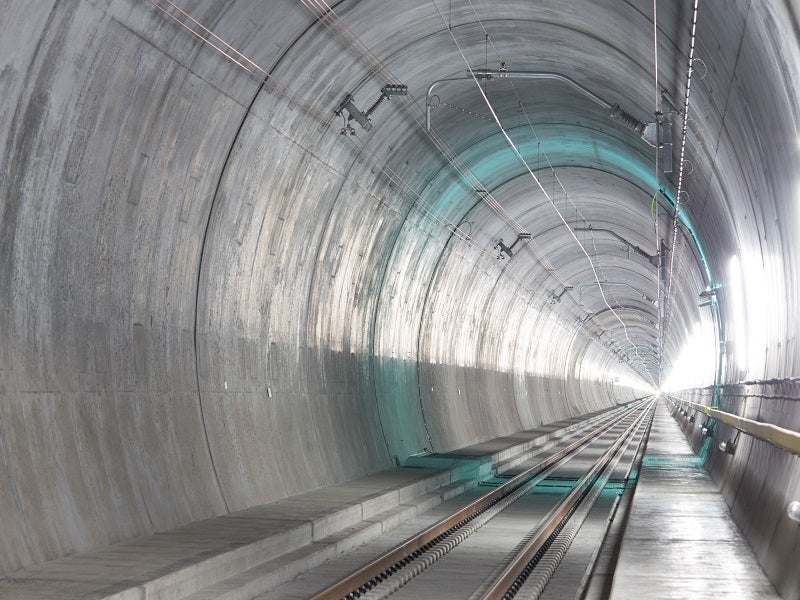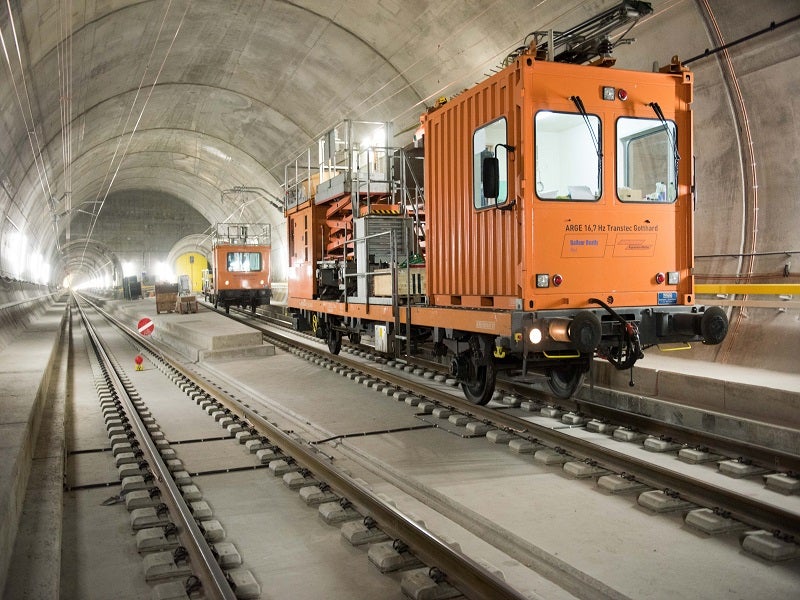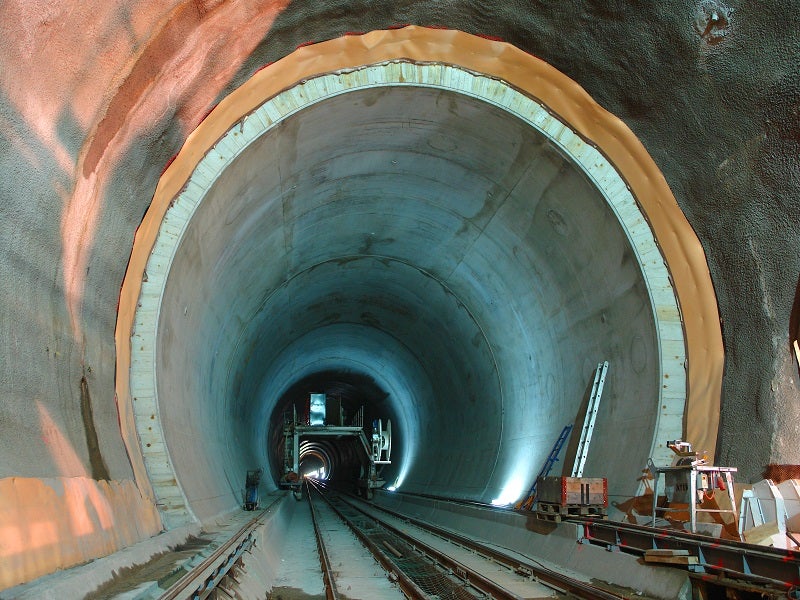A cultural and trading barrier across Europe for centuries, the Alps remains so for transport. Implications have been marked in Switzerland as traffic has largely been in transit, rather than for Swiss producers or consumers. A motorway construction programme and the opening of the Gotthard road tunnel in 1980 greatly encouraged freight by road. General concern was joined by the shock of the multiple fatalities in the Gotthard and Mont Blanc road tunnel accidents.
To control adverse environmental effects, the Swiss constitution incorporated Protection of the Alps in 1994. Previously during 1992, Die Neuen Eisenbahn-Alpentransversalen (NEAT) or the New Rail Link through the Alps (NRLA) programme was approved for building two base tunnels, the 57km-long Gotthard Base Tunnel and 34.6km-long Lotschberg Base Tunnel.
The tunnels were to be relatively level alignments at lower levels than previous tunnels through the massif on the BLS Lotschberg and SBB Gotthard routes. The Gotthard Base Tunnel is the world’s longest railway tunnel, representing the central structure of the New Rail Link through the NRLA. Commercial operations through the partially fitted-out Lotschberg base tunnel began in December 2007.
The test operations for Gotthard Base Tunnel began in October 2015 and the tunnel was officially opened in June 2016. Commercial train services began in December 2016. Further, the third base tunnel, 15.4km-long Ceneri Base Tunnel of the NRLA programme opened in September 2020, marking the completion of the programme.
Gotthard Base Tunnel project details
Controls on road freight were only deemed acceptable by surrounding EU countries if there was improved rail infrastructure, notably at the Lotschberg and Gotthard pinch points. Even with access to dedicated Rollende Landstrasse (RoLa) trains for transit of complete heavy goods vehicles, both north-south routes had long, slow climbs at either side of tunnels at the respective summits and capacity was limited. The NEAT projects were aimed at removing the main limiting factors for the introduction of more, faster and longer trains on the key Rotterdam-Milan rail corridor.
A 100% Swiss Federal Railways (SBB) subsidiary, AlpTransit Gotthard, was established in May 1998 to deliver the project for the 57km (35.4 miles) Gotthard Base Tunnel. Construction was split into five sections, each with a designated consortium, from the north being: Erstfeld (ARGE AGN), Amsteg (ARGE AGN), Sedrun (ARGE Transco-Sedrun), Faido (ARGE TAT) and Bodio (ARGE TAT).
Other contractors are responsible for many other aspects of the project. The estimated final cost of the project was Sfr9.4bn ($9bn) for the Gotthard and Sfr2.24bn for the related 15.4km (9.6 miles) Ceneri tunnel project further south on the route. These amounts exceed the original estimates, with the Swiss parliament approving reserves for uncertainties that included geological conditions, engineering issues and technological developments, the latter relevant due to the long project timescale.
The Gotthard Base Tunnel connects north and south more quickly and reliably for both passengers and goods. It offers unforgettable train rides through the Gotthard Massif, Switzerland’s mythical heart.
Gotthard Base Tunnel infrastructure
Of slightly different length, the base tunnel comprises two bores with two track crossovers and multiple interconnections for foot access between the bores. Entirely to the east of the current Gotthard line, access tracks to the new tunnel joining the present line at Erstfeld in the north and Bodio in the south. At a maximum altitude of 550m, the base tunnel is approximately 600m lower than the present line’s summit and overall renders the Gotthard route no more challenging than many other parts of the SBB network.
To facilitate the project, intermediate shafts were sunk to allow for simultaneous tunnelling on several faces, these points (Erstfeld, Amsteg, Sedrun, Bodio and Faido) to become integrated in the finished structure for servicing and emergency access.
Strict environmental control was in place for the work sites, the material supply chain and for the disposal of spoil.
The tunnels were mainly created by tunnel boring machines, with some use of drilling and blasting. The final section, 7.7km from Erstfeld, began in August 2007 and the breakthrough of the tube at Amsteg was carried out in June 2009.
The final breakthrough in the east tube of the Gotthard Base Tunnel took place in October 2010. It took nearly 14 years and 2,500 workers to connect the two ends of the tunnel. This final breakthrough in the west tube was completed in March 2011.
Aside from the much higher speeds that the new alignment provides, by avoiding the climbs, curves and spirals of the original Gotthard, the project also shortened the route by around 40km (25 miles).
As in the case of the Lotschberg, the old line was retained for local passenger services, for general capacity and as a diversionary route: a noted part of railway tourism, it also provides an interchange with the east-west metre-gauge network via Goschenen.
Rolling stock
With freight most constrained by the present line and many trains needing double-heading for both the north and south ramps, an implication is a reduced need for motive power per train. Increased train lengths and weights are possible through the near-level base tunnel, although in absolute terms the rising traffic demand will not diminish the need for freight locomotives.
Planning allows for advances in freight vehicles to allow for speeds up to 160km/h (100mph) through the tunnel. Longer trains and more of them allow for doubling the present freight capacity on the Gotthard route, much of which are intermodal services, with Alp Transit setting the amount at around 40 million tonnes annually.
The maximum permitted speed for passenger trains travelling through the tunnel is 249km/h, while the freight trains travel at a minimum speed of 100km/h. Freight trains can currently move up to 2,000t from the previous 1,600t.
Domestic passenger services south to Chiasso and Locarno are likely to be formed in part by a next-generation of Swiss coaching stock or units cascaded from elsewhere on the SBB network. Entering line testing in 2008, the ETR 610 from Alstom Ferroviaria is the flagship high-speed unit operating Cisalpino services between Switzerland and Italy. For Zurich-Milan, a 50min reduction to 2h 50min by Cisalpino units is envisaged.
Signalling and communications
Following settlement of a legal challenge over the initial selection, the last major contract worth Sfr1.69bn was signed with the Transtec Gotthard Consortium in April 2008 to fit out the tunnel and approach tracks. Starting at the south portal, the work began in September 2009.
As installed in the Lotschberg, the Gotthard and Ceneri tunnels are fitted with ETCS / ERTMS Level 2 that obviates trackside signals. A leading adopter of the EC-sponsored system, non-EC Switzerland is advanced in the equipping of its rolling stock with the required equipment.
Thales, as part of the Transtec Gotthard Consortium, supplied, installed and tested all the ETCS Level 2 systems and the centralised traffic control systems.
Contractors involved
In April 2011, a consortium of ABB and TLT Turbo won a $45m contract to provide a ventilation system for the Gotthard Base Tunnel. The contract involved the supply of medium-voltage and low-voltage switchgear and other electrical equipment, and carrying out cable design and delivery, installation, assembly and commissioning of other components.
Siemens provided the tunnel control systems and fire protection systems for the railway tunnel. NORMA supplied its proprietary NORMACONNECT FLEX pipe couplings to connect the rainwater pipes in the tunnel. Datwyler supplied silicon sealing solutions for the Gotthard Base Tunnel.
Webuild Group and its consortium partners were awarded a contract worth €80m ($95.2m) in March 2021 to construct a 4km-long access tunnel at the north end of the Gotthard Tunnel.
The contract will pave the way for the expansion of the highway that passes through the tunnel, as well as contribute to the development of sustainable travel in the Swiss Alps.










